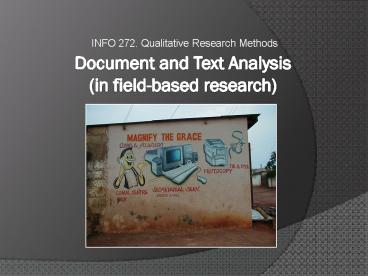Document and Text Analysis (in field-based research) - PowerPoint PPT Presentation
Title:
Document and Text Analysis (in field-based research)
Description:
INFO 272. Qualitative Research Methods * * * * * * * * * Outline Classic Content Analysis Lightweight Document Analysis Heavy-duty Document Analysis Analyzing the ... – PowerPoint PPT presentation
Number of Views:36
Avg rating:3.0/5.0
Title: Document and Text Analysis (in field-based research)
1
Document and Text Analysis (in field-based
research)
- INFO 272. Qualitative Research Methods
2
Outline
Classic Content Analysis
Lightweight Document Analysis
Heavy-duty Document Analysis
Analyzing documents encountered in fieldwork
practice tangential to larger social process
Analyzing the contents of documents in isolation
Collection and analysis of documents in context
is the center and focus of the project. in order
to, for example define requirements for
information system design, improve business
processes see Glushko 2005
3
Review of Readings
- What accounts for incomplete, badly kept records?
- What is the context within which records are
produced?
4
Classic content analysis
5
Units and Dimensions
- Syntax vs. Semantics
- Units Words, sentences, paragraphs, articles
- Also, propositional units
- biotechnology, the most recent among post-war
base technologies, enters the public arena in the
1990s - biotechnology enters the public arena in the
1990s - biotechnology is a base technology
- biotechnology is a base technology of the
post-war period - biotechnology is the most recent base
technology - source Martin Bauer, Classical content
analysis
6
Method
- Sample documents (can even do a random sample)
- Divide documents into units
- syntactical vs. semantic elements
- Articles, words, sentences, themes, propositions
- Construct a coding frame and assign codes to
units - Calculate frequencies
7
Purpose
- Media monitoring can be a continually updated
evaluation frame - Comparisons (between newspapers, between
audiences, against standards) - Construct indices (of societal values) how
people describe themselves and ideal partners in
lonely hearts columns - source Martin Bauer, Classical content
analysis
8
Document analysis Lightweight
9
Projective Interviewing
- Collecting encountered documents from the field
- Incorporating collected documents into interviews
10
Projective Interviewing
J um, I kept the brochure, that said that the
church was changing destinies and taking new
territories and I wondered if you could sort of
explain what that means for the church? M
yeah, um, changing destinies means that
peoplelook at their lives in a particular way.
For example, people who would look at the
patterns in their family and they may say well
all our family, everybody is an alcoholic so Im
more likely to become an alcoholic or people
looking to their families and say that we all
come from very poor backgrounds so we are all
likely to become poor and so you know, they have
a mentality that predates and is based on what
theyve been told
11
World Summit on the Information Society
- Content analysis of collected documents
- Combined with other forms of data to make an
argument about inclusiveness
12
Document analysis Heavy-Duty
13
Readings record of medical clinic consultation
- Examining document contents
- Identify categories
- Ordering of text within a unit (i.e. a single
entry in the medical record) - The geography of entries
- Inferences drawn from what is not written
14
Readings record of medical clinic consultation
- Observing documents in the field
- Document within doctor/patient interaction
- Written for what audience?
15
ReadingsOutcome of the Analysis
- Critique of motivation to digitize records
- What are the bad organizational reasons for
good clinical records? - Systematic data entry interferes with expressing
ambivalence, subtlety, with strategic ordering
and omission
16
Document analysis Final Thoughts
17
Interrogating your documents
- Who is the author? Are they identified or not?
- Is it bound with other documents and where is its
placement? - What is the document material?
- Is it written or printed? What can you say about
the fonts, size? - Is a signature on a document required and what
does it mean?
18
In Summary
- Limits of content analysis
- Lightweight document analysis where documents
support central research concern - Heavy-duty document analysis where documents are
the central research concern































